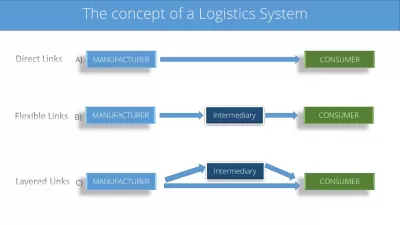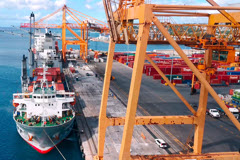物流系统的概念
The 后勤 system is an essential element for a successful business
Today, it is relevant that the 后勤 system is an integral element for the stable functioning of a business in today's market conditions.
A 后勤 system is a complex organizationally completed economic system that consists of subsystems interconnected in a single process of managing financial, personnel, material, information, service and related flows, and the tasks of functioning of these links are united by the internal goals of the business organization and external goals.
Let us consider in more detail the concept of a 后勤 system, its purpose, properties and types.
The concept of a 后勤 system
There are various systems that ensure the functioning of the economic mechanism. In this set, it is necessary to single out the 后勤 systems in order to analyze and improve them.
The generally accepted definition of a 后勤 system says that a 后勤 system is an adaptive feedback system that performs certain 后勤 functions. It, as a rule, consists of several subsystems and has developed connections with the external environment.
The purpose of the 后勤 system is the delivery of goods and products to a given place, in the right quantity and assortment, prepared to the maximum extent possible for industrial or personal consumption at a given level of costs.
The 后勤 system is characterized by a number of properties:
- 系统要素的兼容性(通过最终目标的统一确保);
- the relationship of the elements of the 后勤 system (in external systems, the relationship is ensured by the conclusion of an agreement between the parties, in the internal 后勤 system, the relationship is provided by intra-production relations of the elements);
- 系统元素之间的连接,具有一定的顺序,组织;
- 一个积分属性(系统的单个元素单独能够执行系统的功能,即以最小化总成本的采购,生产和营销;系统的每个元素都可以正常工作并仅实现最终的后勤目标与其他元素)。
The objects of the 后勤 system are enterprises and organizations that have a bank account, their own seal, an independent balance sheet (industrial, construction, transport, supply and marketing organizations); glossings (regional and interregional complexes - fuel and energy, energy systems and associations, etc).
All objects operating outside the 后勤 system belong to the external environment and are included in other 后勤 systems.
宏观和微观学系统
In many sources, 后勤 systems are divided into macro后勤 and micro后勤.
宏观的系统是一个庞大的材料流管理系统,涵盖了该国不同地区各个部门的工业企业和组织,中介,贸易和运输组织。宏观制度是一个地区,国家或国家群体的经济基础设施。在形成涵盖不同国家的宏观努力系统时,有必要克服与国际经济关系的法律和经济特征相关的困难,以及供应商品的不平等条件,国家运输法规的差异以及许多其他障碍。州际计划中宏观逻辑系统的形成需要创建一个单一的经济空间,一个没有内部边界的单一市场,对商品运输,资本,信息和劳动力资源运输的海关障碍。
显微学系统是子系统,宏观系统的结构组成部分。其中包括各种工业和商业企业,领土生产综合体。显微学系统是一类生产内物流系统,其中包括与单个基础设施联合的技术相关行业。
通过连接的物流系统类型
物流系统有三种类型:具有直接链接,灵活和分层的物流系统。
具有直接连接的物流系统。材料流直接从产品生产国传递到消费者%%(例如,电力的生产和消耗)。
分层物流系统。材料流的路径上至少有一个中介。例如,计算机技术电子元素的批发基础。
灵活的物流系统。从生产者到消费者的材料流动的运动可以直接和中介进行。例如,从冶金工厂的交付是按照大型机器建设企业的订单进行的,也可以转到批发基地,以出售给中小型企业。
总结有关物流系统的数据
从系统理论的角度来看,物流系统是执行某些物流功能和操作的自适应反馈系统。物流系统可以由几个子系统组成,并已与外部环境建立了联系。
物流系统是企业在当今市场条件下稳定运作的基本要素。
这是一个复杂的组织经济系统,由在管理所有类型的物流系统中管理财务,人员,材料,信息,服务和相关流程的单一过程中相互联系的子系统组成。作为物流系统,可以考虑各种企业 - 工业,贸易,运输,金融,中介及其综合体。
与任何其他系统一样,物流系统具有某些属性:
- 完整性 - 系统部分与单个有目的活动的内部关系。完整性的基础是各个部分的紧密互连。
- 自治 - 无论环境如何,系统在相当广泛的范围内运行和发展的能力。
- 内部连接 - 系统的元素相互连接,而系统元素之间的连接比系统元素与外部环境的连接更强。内部链接以某种方式排序,即形成系统的结构。
- 系统的复杂性取决于元素数量,其相互作用的性质,执行功能的复杂性,环境因素等。
- 与环境的互动。
物流系统的标志是流过程和系统完整性的存在。
常见问题
- 本文讨论的物流系统的基本组成部分是什么?
- 本文概述了物流系统的基本组成部分,包括运输,仓储,库存管理,订单处理以及这些组件的集成以进行有效的商品运输和供应链管理。

Freelancer,作者,网站创建者和SEO专家Elena也是税务专家。她的目标是使高质量的信息最多可用,以帮助他们改善个人和职业生活。

